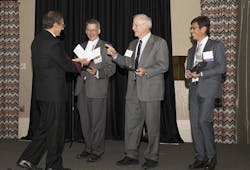Free-Electron Laser Prize won by Los Alamos scientists Carlsten, Nguyen, and Sheffield
Image. Los Alamos scientists Bruce Carlsten, Richard Sheffield, and Dinh Nguyen receive the 2017 Free Electron Laser Prize at an international conference hosted in Santa Fe. Courtesy Los Alamos National Laboratory
At an international science conference hosted recently in Santa Fe, NM, Los Alamos National Laboratory scientists Bruce Carlsten, Dinh Nguyen, and Richard Sheffield were awarded the 2017 Free-Electron Laser (FEL) Prize. The honor is an international recognition of key technologies that originally developed at Los Alamos in the 1980s and 1990s, such as the radio frequency photo-injector and high-brightness electron beams. These significant innovations also have enabled the x-ray free-electron laser (XFEL) facilities currently in use worldwide.
"The very brightest sources of x-rays are the latest generation of x-ray 'light sources' called free electron lasers," said Laboratory physicist Cris Barnes. "And those free electron lasers would be far less likely to exist and work without the pioneering contributions recognized by this year's FEL Prize." These ground-breaking innovations paved the way for all of the current ultra-bright fourth-generation light sources that are revolutionizing many fields of science, from biology to materials science.
The honor called out three specific pioneering contributions:
- The invention, first practical demonstration and theoretical understanding of the radio-frequency photo-injector, patented in 1985
- The first practical demonstration of self-amplified spontaneous emission
- The design and demonstration of the regenerative amplifier free-electron laser.
Free-electron lasers involve techniques and materials central to the Los Alamos National Laboratory mission: X-rays are used to examine the inside of all materials, from living tissues to the parts in nuclear weapons. High-energy and very bright sources of x-rays provide the ability to penetrate deep into materials and provide very fast response to changing conditions.
Related: China develops 'world's brightest' VUV free-electron laser research facility
Related: Free electron lasers thrive from synergy with ultrafast laser systems
The FEL is central to the Laboratory's proposed future flagship experimental science facility, Matter-Radiation Interactions in Extremes (MaRIE). Sponsored by Los Alamos, the International Free Electron Laser Conference, a five-day biennial conference held in Santa Fe, brought together an international perspective on recent advances in free electron laser theory, experiments, electron beam technology and applications of free-electron lasers. Nguyen and Carlsten served on the conference organizing committee. The FEL Prize Committee was composed of five members who work at institutions other than Los Alamos.
About the Author

Conard Holton
Conard Holton has 25 years of science and technology editing and writing experience. He was formerly a staff member and consultant for government agencies such as the New York State Energy Research and Development Authority and the International Atomic Energy Agency, and engineering companies such as Bechtel. He joined Laser Focus World in 1997 as senior editor, becoming editor in chief of WDM Solutions, which he founded in 1999. In 2003 he joined Vision Systems Design as editor in chief, while continuing as contributing editor at Laser Focus World. Conard became editor in chief of Laser Focus World in August 2011, a role in which he served through August 2018. He then served as Editor at Large for Laser Focus World and Co-Chair of the Lasers & Photonics Marketplace Seminar from August 2018 through January 2022. He received his B.A. from the University of Pennsylvania, with additional studies at the Colorado School of Mines and Medill School of Journalism at Northwestern University.
